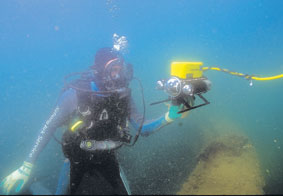New Submarine Camera Search for Nessie
Posted by: John Kirk on May 4th, 2007
The struggle to document the Loch Ness phenomenon goes on. For a Loch that has been searched with an army of investigators over the years, yielding little in the way of results, we now find yet another group who are highly optimistic (judging by the article below) that they might find the creature by next week.
Hunting party goes after Nessie — with sub cams
EVIDENCE that the Loch Ness Monster exists could be produced next week — even if the mysterious creature decides to eat the camera technology which could discover it.
Up to 15 shoebox-sized metallic submarines — called “VideoRays” — will enter the loch as part of a “Monster Gathering” arranged by Aberdeen company Buccaneer, which sells the equipment for £3500 to £20,000.
A diver with one of Buccaneer’s unmanned submarine cameras.
The remote-controlled boxes have cables leading to a control box on the surface, with at least one able to drop to 300 metres — close to the bottom of the loch.
The firm’s managing director Ian MacDonald explained the boxes would beam images to monitors which would record everything seen underwater on Wednesday and Thursday next week.
“I’m fairly confident that we will be left with a question mark, as these things always do,” said Mr MacDonald, when asked about Nessie, the recently heralded Highland 2007 icon.
He explained that even if The Loch Ness Monster was feeling peckish and ate the equipment there would still be a chance to see something.
“Until the cable was broken we would be able to get pictures,” said Mr MacDonald.
“We have a colleague in the United States who had one half way down the throat of an alligator and he had an excellent view of the alligator’s teeth right up until the bite closed.”
Around 20 of the company’s workers and customers will be joined by colleagues from the US and stay next to the Loch Ness Exhibition Centre and Drumnadrochit Hotel.
Mr MacDonald, who opened the business almost five years ago, has a history in electronics.
“We’ve played up the monster side of it a bit perhaps, but there is some serious science we want to go and look at,” he added.
The group aims to investigate a 50-metre patch on the bed of the loch known as the “Monster’s footprint” — and try to discover if there are any remaining parts of the Second World War Wellington bomber which was raised from the loch in the 1980s.
“You’re always hopeful to find something new and interesting and if you can do some proper investigative work while you’re at it, it’s a bonus,” he said. “But you’re never quite sure until the vehicle is in the water what you’re going to find.
“In almost any body of water you’re going to find something that’s fairly unexpected.”
Nessie hunter Steve Feltham, who has been based on Dores beach recording his view of the surface of Loch Ness for 16 years, is still “mildly” confident of seeing the elusive creature, but he said this group might not have much luck.
“The odds are so stacked against anybody actually finding anything here.
“If they didn’t have such a fanfare at the beginning there wouldn’t be such an anticlimax a week later when they pack up and go home,” he commented.
“I’m glad that these people come here and try something.
“I would think that if I had the money to do it, I would be out there playing about with a submarine, because it sounds great.”
Robbie Bremner, managing director at the Loch Ness Exhibition Centre, said the magic of the area would always attract tourists.
“People don’t come for the Loch Ness Monster,” he said. “They come for the scenery, they come for the friendliness and hospitality of the people, and they come for the romance of Loch Ness.
“They are always happy when they arrive here and are always happy when they leave.”Andy Dixon
The Inverness Courier
I am in agreement with Steve Feltham that all this hullabaloo at the beginning of this enterprise needs to be avoided as there is no feeling worse than making huge public proclamations about success then having to return home with your tail between your legs.
Optical equipment really isn’t suited to Loch Ness as the waters there are heavily peat-stained and it is incredibly murky down there. If I were to attempt another expedition there, I would definitely use sonar as the results would be an improvement on shadowy photos that usually result from underwater photography.
Again, like Steve Feltham, I am glad to see people with a spirit of enterprise trying to solve a mystery that just does not seem to want to go away until it is determined one way or another that there is or isn’t a Loch Ness cryptid.
About John Kirk
One of the founders of the BCSCC, John Kirk has enjoyed a varied and exciting career path. Both a print and broadcast journalist, John Kirk has in recent years been at the forefront of much of the BCSCC’s expeditions, investigations and publishing. John has been particularly interested in the phenomenon of unknown aquatic cryptids around the world and is the author of In the Domain of the Lake Monsters (Key Porter Books, 1998).
In addition to his interest in freshwater cryptids, John has been keenly interested in investigating the possible existence of sasquatch and other bipedal hominids of the world, and in particular, the Yeren of China. John is also chairman of the Crypto Safari organization, which specializes in sending teams of investigators to remote parts of the world to search for animals as yet unidentified by science. John travelled with a Crypto Safari team to Cameroon and northern Republic of Congo to interview witnesses among the Baka pygmies and Bantu bushmen who have sighted a large unknown animal that bears more than a superficial resemblance to a dinosaur.
Since 1996, John Kirk has been editor and publisher of the BCSCC Quarterly which is the flagship publication of the BCSCC. In demand at conferences, seminars, lectures and on television and radio programs, John has spoken all over North America and has appeared in programs on NBC, ABC, CBS, PBS, TLC, Discovery, CBC, CTV and the BBC.
In his personal life John spends much time studying the histories of Scottish Clans and is himself the president of the Clan Kirk Society. John is also an avid soccer enthusiast and player.











A VideoRay would provide the best chance for verifying the identity of the Monster’s footprint which is a stationery object. But as for filming moving cryptids in deep lakes I had this other idea. Hopefully it’s doable. We’ve heard stories of how the US Navy uses trained pilot whales for undersea operations. Can dolphins or porpoises survive in fresh water? Some seals can like those found in Lake Baikal or the Caspian Sea. Small underwater cameras can be attached on their foreheads. Being living organisms they might get attracted to the cryptid or the cryptid might get attracted to them. This might be a good way to photograph elusive creatures in inconvenient underwater environments.
One of the biggest issues I have heard a number of times on this, is the lack of sustainable food. This lock is not a heavy populated environment for fish, and would not supply enough food for this creature. The only problem with this idea, is the 196? sighting of the creature that was carrying a sheep back to the water. I am not sure of if that report was ever verified though.
Actually I think the best way would be to fit a small 2 man sub with enough sonar equipment and some cameras (only if they were to get close to the creature) and rely about 98% on the sonar due to the water quality.
Are the waters always peat-stained or only after significant runoff? I used to watch an underwater webcam, which I can no longer locate by the way, and the visibility was as good as that of a plankton rich BOW. While we are on Nessie. What do you think of the tooth story? A video on youtube shows some kids who discovered a mutilated deer and a tooth that looks like a lobster claw but isn’t.
Response to:
Optical equipment really isn’t suited to Loch Ness as the waters there are heavily peat-stained and it is incredibly murky down there
Maybe they could make a camera that’s “fish flavored”? 🙂
The interesting thing is that Loch Ness and its “creature” have given people a good excuse to try new technologies that might work well in other situations making the loch a sort of natural lab. I mean, heck, if you can get good pictures in Loch Ness you should be able to get good pictures about anywhere. The bonus side might be that they get a look at something unusual like Nessie.
As long as people are searching I’m for whatever they want to try. Good luck and good hunting.
One of the biggest issues I have heard a number of times on this, is the lack of sustainable food. This lock is not a heavy populated environment for fish, and would not supply enough food for this creature.
A common misconception. There is plenty of food in the loch. Indeed salmon even come into the loch by way of the river Ness. There is also an abundance of eels in the loch.
Granted, there probably isn’t enough food in the loch to sustain a large population of aquatic dinosaurs (LOL) but I don’t think anybody these days seriously thinks that is what Nessie is.
nessie, nessie, nessie…I HAVE ALREADY PROVED THAT, YES IT EXISTED BUT IS NOW EXTINCTED!!! the “loch ness monster” is merely a plesiosaur that did not die with the other dinosaurs, maybe there was a couple that survived in an underwater lair….